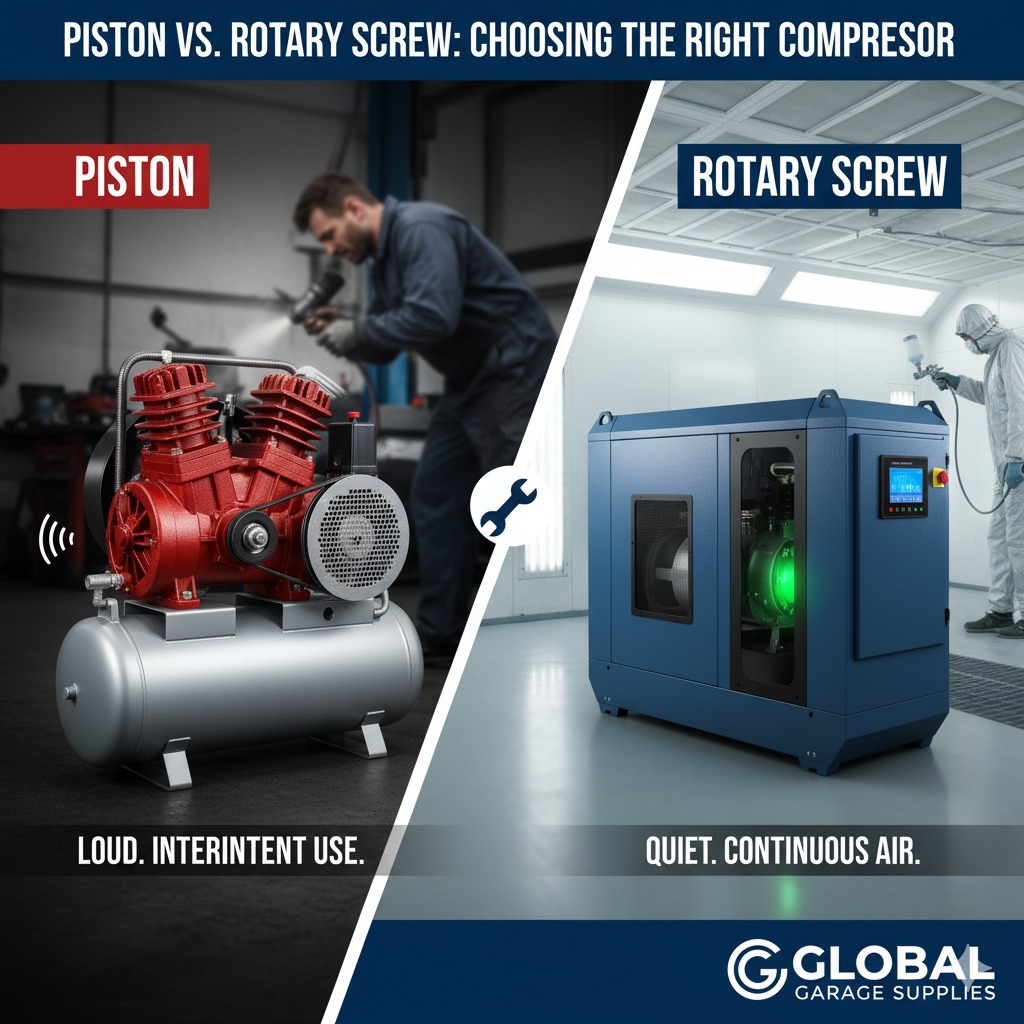Buying an air compressor based solely on a big tank or a high horsepower (HP) number is a common, and costly, mistake. In the professional garage, the true measure of a compressor’s ability is its CFM (Cubic Feet per Minute) delivery at a specific PSI (Pounds per Square Inch). Undersizing your compressor leads to constant running, overheating, pressure drops, and ultimately, tool malfunction.
At Global Garage Supplies, we believe in powering your shop efficiently. This practical guide will walk you through the essential steps to accurately calculate your true CFM needs so you can select the perfect Air Compressor.
Step 1: Inventory Your Pneumatic Tools
Start by listing every pneumatic tool in your shop. For each tool, find the required CFM rating, which is typically stamped on the tool or listed in its manual. This rating is usually measured at 90 PSI.
| Tool Type | Example CFM @ 90 PSI | Usage Pattern |
| 1/2″ Impact Wrench | 4–6 CFM | Intermittent |
| Air Ratchet | 3–5 CFM | Intermittent |
| Die Grinder | 8–12 CFM | Continuous |
| Dual Action Sander | 10–14 CFM | Continuous |
| Air Hammer | 5–8 CFM | Intermittent |
Step 2: Determine Peak Simultaneous Usage
This is the most critical step. You rarely run only one tool at a time. Estimate the maximum number of tools that will be running simultaneously during your busiest period.
- Rule of Thumb (General Shop): For a 3-bay shop with three mechanics, assume at least 1-2 impact wrenches and 1-2 ratchets could be running briefly, and one continuous tool (like a die grinder or sander) could be running for a longer stretch.
Step 3: Calculate Your Total Base CFM Requirement
Take your list from Step 2 and calculate the required CFM. Crucially, do not simply add up the CFM for every tool you own. Add up the CFM for the tools you estimate will run at the same time.
- Example Peak Demand Calculation:
- One Die Grinder (Continuous): 12 CFM
- One 1/2″ Impact Wrench (Intermittent): 6 CFM
- One Air Ratchet (Intermittent): 4 CFM
- Total Base CFM: $12 + 6 + 4 = 22$ CFM
Step 4: Add the Safety and Future-Proofing Margins
Compressors lose efficiency over time, and your shop will eventually add new tools. You must always add safety margins to your total:
- Efficiency Margin (20%): Add 20% to your base CFM to account for pressure drops, piping losses, and compressor wear.
- $22\text{ CFM} \times 0.20 = 4.4\text{ CFM}$
- Future Growth Margin (10-15%): Add a buffer for future expansion or adding higher-CFM specialty tools.
- $22\text{ CFM} \times 0.15 = 3.3\text{ CFM}$
- Total Required CFM: $22\text{ (Base)} + 4.4\text{ (Efficiency)} + 3.3\text{ (Growth)} = 29.7\text{ CFM at 90 PSI}$
In this example, you need an Air Compressor capable of reliably delivering 30 CFM at 90 PSI or greater.
Matching CFM to Motor and Tank
- CFM & HP: CFM output correlates to horsepower. A high-performance 7.5 HP industrial piston compressor typically delivers around 24–28 CFM. A 10 HP industrial piston compressor delivers closer to 34–38 CFM. Given our 30 CFM need, a robust 10 HP model is a safe investment. For continuous use, consider a Rotary Screw Compressor which delivers better CFM per HP.
- Tank Size: The receiver tank (e.g., 80-gallon or 120-gallon) does not determine the compressor’s output, but it acts as a buffer. A larger tank handles short, high-CFM bursts better, reducing the number of times the compressor motor has to cycle on and off, which extends the life of the motor.
Don’t let air shortages dictate your service speed. By precisely calculating your CFM needs, you ensure you select an Air Compressor that provides reliable, consistent power, leading to maximized shop efficiency and longevity.
Find the right-sized, professional-grade Air Compressor for your calculated needs at Global Garage Supplies today.

